Experimental Study on the Optimal Strategy for Power Regulation of Governing System of Hydropower Station
Abstract
:1. Introduction
- (1)
- Establishing a reasonable mathematical model of HTGS considering nonlinear turbine characteristics in the power control mode.
- (2)
- Proposing a novel power control strategy based on the S-curve control algorithm to effectively suppress the power oscillation and reverse power regulation under the power control mode.
- (3)
- Verifying the excellence of the proposed optimal control strategy based on the S-curve control algorithm by conducting field tests in a real hydropower station.
2. Mathematical Model
2.1. Hydro-Turbine Governing System Model
2.2. Hydraulic Turbine Model
2.3. Penstock System Model
2.4. Generator Model
3. Methods
3.1. Brief Introduction to Active Power Regulation
3.2. Problem Formulation
3.3. Power Oscillation Versus Reverse Power Regulation
3.4. S-curve Regulation for Power Oscillation Control
3.5. Power Regulation Dynamic Response Index
- (1)
- The maximum overshoot of the active power must not exceed 45% of the disturbance .
- (2)
- When the target value variation of the active power is not less than 25% of the rated active power Pr of the hydro-generator unit, the power regulation time ts cannot exceed 45 s; when the power variation is equivalent to 5–25% of the rated active power, the power regulation time ts cannot exceed 30–45 s.
- (3)
- Within the power regulation time ts, the fluctuation Z with the power deviation greater than 5% of Pr cannot occur more than twice.
4. Results and Discussion
4.1. Engineering Case
4.2. Comparison of Small Power Change Test
4.3. Comparison of Large Power Change Test
4.4. Discussion
5. Conclusions
- (1)
- In comparison with the conventional linear control algorithm, the S-curve control algorithm greatly promotes the regulation speed, precision, and stability in the dynamic response process of power regulation, especially in the power regulation process with large power variations.
- (2)
- The S-curve control algorithm adopts the slow acceleration mode when the guide vane starts and stops moving in the process of power regulation. This helps prevent the impact caused by the guide vane at the moment of movement, relieve the water hammer effect, and reduce the peak value of the reverse power regulation and the power overshoot.
- (3)
- Nonlinear factors of the hydro-generator unit, such as the inertia time constant Tw of the water flow, acceleration inertia time constant Ta of the unit, and nonlinear relation between the guide vane opening and the turbine output power, will affect the power regulation quality of dynamic response.
Author Contributions
Funding
Institutional Review Board Statement
Informed Consent Statement
Data Availability Statement
Acknowledgments
Conflicts of Interest
References
- Hydropower Status Report. Available online: https://www.hydropower.org/statusreport (accessed on 10 May 2020).
- China Renewable Energy Development Report 2019. Available online: https://www.natureindex.com/institution-outputs/china/china-renewable-energy-engineering-institute-creei-power-china/5588b4e2140ba0e07b8b456e (accessed on 1 November 2019).
- China Electricity Council. Available online: https://www.cec.org.cn (accessed on 1 May 2020).
- China National Energy Administration. Available online: http://www.nea.gov.cn (accessed on 1 March 2020).
- Hou, H.; Xu, T.; Wu, X.; Wang, H.; Tang, A.; Chen, Y. Optimal capacity configuration of the wind-photovoltaic-storage hybrid power system based on gravity energy storage system. Appl. Energy 2020, 271, 115052. [Google Scholar] [CrossRef]
- Campos, R.A.; do Nascimento, L.R.; Rüther, R. The complementary nature between wind and photovoltaic generation in Brazil and the role of energy storage in utility-scale hybrid power plants. Energy Convers. Manag. 2020, 221, 113160. [Google Scholar] [CrossRef]
- Poompavai, T.; Kowsalya, M. Control and energy management strategies applied for solar photovoltaic and wind energy fed water pumping system: A review. Renew. Sustain. energy Rev. 2019, 107, 108–122. [Google Scholar] [CrossRef]
- Nautiyal, H.; Goel, V. Sustainability assessment of hydropower projects. J. Clean. Prod. 2020, 265. [Google Scholar] [CrossRef]
- Li, H.; Xu, B.; Riasi, A.; Szulc, P.; Chen, D.; M’zoughi, F.; Skjelbred, H.I.; Kong, J.; Tazraei, P. Performance evaluation in enabling safety for a hydropower generation system. Renew. Energy 2019, 143, 1628–1642. [Google Scholar] [CrossRef]
- Li, H.; Chen, D.; Gao, X.; Wang, X.; Han, Q.; Wu, C. Fast-slow dynamics of a hydropower generation system with multi-time scales. Mech. Syst. Signal Process. 2018, 110, 458–468. [Google Scholar] [CrossRef]
- Yu, X.; Yang, X.; Jian, Z. Stability analysis of hydro-turbine governing system including surge tanks under interconnected operation during small load disturbance. Renew. Energy 2019, 133, 1426–1435. [Google Scholar] [CrossRef]
- Xu, B.; Chen, D.; Zhang, H.; Wang, F. Modeling and stability analysis of a fractional-order Francis hydro-turbine governing system. Chaos, Solitons & Fractals 2015, 75, 50–61. [Google Scholar]
- Xu, X.; Guo, W. Stability of speed regulating system of hydropower station with surge tank considering nonlinear turbine characteristics. Renew. Energy 2020, 162, 960–972. [Google Scholar] [CrossRef]
- Yang, W.; Yang, J.; Zeng, W.; Tang, R.; Hou, L.; Ma, A.; Zhao, Z.; Peng, Y. Experimental investigation of theoretical stability regions for ultra-low frequency oscillations of hydropower generating systems. Energy 2019, 186. [Google Scholar] [CrossRef]
- Liu, D.; Wang, X.; Peng, Y.; Zhang, H.; Xiao, Z.; Han, X.; Malik, O.P. Stability analysis of hydropower units under full operating conditions considering turbine nonlinearity. Renew. Energy 2020, 154, 723–742. [Google Scholar] [CrossRef]
- Leonov, G.A.; Kuznetsov, N.V.; Solovyeva, E.P. A simple dynamical model of hydropower plant: stability and oscillations. IFAC-PapersOnLine 2015, 48, 656–661. [Google Scholar] [CrossRef]
- Kuznetsov, N.V.; Yuldashev, M.V.; Yuldashev, R.V. Analytical-numerical analysis of closed-form dynamic model of Sayano-Shushenskaya hydropower plant: stability, oscillations, and accident. Commun. Nonlinear Sci. Numer. Simul. 2021, 93. [Google Scholar] [CrossRef]
- Wang, G.; Xu, Z.; Guo, X.; Xiao, L. Mechanism analysis and suppression method of ultra-low-frequency oscillations caused by hydropower units. Int. J. Electr. Power Energy Syst. 2018, 103, 102–114. [Google Scholar] [CrossRef]
- Yu, X.; Yang, X.; Liu, Z.; Zhang, J. Mechanism and quantified criteria of stability characteristics of hydropower plants with surge tanks during regulation. Int. J. Electr. Power Energy Syst. 2020, 122. [Google Scholar] [CrossRef]
- Guo, W.; Peng, Z. Order reduction and dynamic performance of hydropower system with surge tank for grid-connected operation. Sustain. Energy Technol. Assessments 2020, 40. [Google Scholar] [CrossRef]
- Guo, W.; Yang, J. Dynamic performance analysis of hydro-turbine governing system considering combined effect of downstream surge tank and sloping ceiling tailrace tunnel. Renew. Energy 2018, 129, 638–651. [Google Scholar] [CrossRef]
- He, C.; Dong, H.; Dong, P.; Su, H.; Wang, X.; Ding, Y. Engineering analysis and optimization on typical control strategy of primary frequency modulation and automatic generation control of hydropower unit. Autom. Electr. Power Syst. 2015, 39, 146–150. [Google Scholar]
- Bao, H.; Long, Y.; Fu, L.; Wei, J. Study on stability of load regulation transition process of hydro turbine governor in power regulation mode. Trans. Chin. Soc. Agric. Eng. 2019, 35. [Google Scholar] [CrossRef]
- Wei, S. Hydraulic Turbine Regulation; Huazhong University of Science and Technology Press: Wuhan, China, 2009. [Google Scholar]
- Yang, W.; Yang, J.; Guo, W.; Zeng, W.; Wang, C.; Saarinen, L.; Norrlund, P. A mathematical model and its application for hydro power units under different operating conditions. Energies 2015, 8, 10260–10275. [Google Scholar] [CrossRef]
- Yang, W.; Yang, J.; Guo, W.; Norrlund, P. Frequency stability of isolated hydropower plant with surge tank under different turbine control modes. Electr. Power Components Syst. 2015, 43, 1707–1716. [Google Scholar] [CrossRef] [Green Version]
- Yang, W.; Norrlund, P.; Chung, C.Y.; Yang, J.; Lundin, U. Eigen-analysis of hydraulic-mechanical-electrical coupling mechanism for small signal stability of hydropower plant. Renew. Energy 2018, 115, 1014–1025. [Google Scholar] [CrossRef]
- Guo, W.; Yang, J. Stability performance for primary frequency regulation of hydro-turbine governing system with surge tank. Appl. Math. Model. 2018, 54, 446–466. [Google Scholar] [CrossRef]
- An, H.; Yang, J.; Yang, W.; Cheng, Y.; Peng, Y. An improved frequency dead zone with feed-forward control for hydropower units: performance evaluation of primary frequency control. Energies 2019, 12. [Google Scholar] [CrossRef] [Green Version]
- Fu, L.; Wei, J.; Huang, B. Study on factors of influence on electricity contribution of primary frequency modulation of hydro-power unit. Water Resour. Hydropower Eng. 2020, 51, 103–110. [Google Scholar]
- Du, L.; Bao, H.; Huang, B. Study on active power regulation of hydropower unit monitoring system. J. Hydroelectr. Eng. 2020, 39, 62–71. [Google Scholar]
- Wei, J.; Guili, Z.; Zuohong, M.; Pei, Z. Power regulation mode study based on three-stage speed regulation of hydropower unit. Hydropower Autom. Dam Monit. 2014, 38, 26–30. [Google Scholar]
- Fu, L. Optimization of governor power mode for hydro-turbine units with slope ceiling tail tunnels. J. Hydroelectr. Eng 2018, 37, 88–95. [Google Scholar]
- Chen, Y.; Li, X. Active power regulation based on adaptive PID controller. Large Electr. Mach. Hydraul. Turbine 2016, 2016, 62–64. [Google Scholar]
- Erkorkmaz, K.; Altintas, Y. High speed CNC system design. Part I: Jerk limited trajectory generation and quintic spline interpolation. Int. J. Mach. Tools Manuf. 2001, 41, 1323–1345. [Google Scholar] [CrossRef]
- Li, D.; Wu, J.; Wan, J.; Wang, S.; Li, S.; Liu, C. The implementation and experimental research on an S-curve acceleration and deceleration control algorithm with the characteristics of end-point and target speed modification on the fly. Int. J. Adv. Manuf. Technol. 2017, 91, 1145–1169. [Google Scholar] [CrossRef]
- Lu, T.-C.; Chen, S.-L.; Yang, E.C.-Y. Near time-optimal s-curve velocity planning for multiple line segments under axis constraints. IEEE Trans. Ind. Electron. 2018, 65, 9582–9592. [Google Scholar] [CrossRef]
- Tsai, Y.-F.; Farouki, R.T.; Feldman, B. Performance analysis of CNC interpolators for time-dependent feedrates along PH curves. Comput. Aided Geom. Des. 2001, 18, 245–265. [Google Scholar] [CrossRef]
- Chen, Z.; Yuan, X.; Ji, B.; Wang, P.; Tian, H. Design of a fractional order PID controller for hydraulic turbine regulating system using chaotic non-dominated sorting genetic algorithm II. Energy Convers. Manag. 2014, 84, 390–404. [Google Scholar] [CrossRef]
- Fang, H.; Chen, L.; Dlakavu, N.; Shen, Z. Basic modeling and simulation tool for analysis of hydraulic transients in hydroelectric power plants. IEEE Trans. energy Convers. 2008, 23, 834–841. [Google Scholar] [CrossRef]
- Working Group Prime Mover and Energy Supply. Hydraulic turbine and turbine control models for system dynamic studies. IEEE Trans. Power Syst. 1992, 7, 167–179. [Google Scholar] [CrossRef]
- Zheng, Y.; Zhang, J. Transient Process of Hydraulic Unit; Peking University Press: Beijing, China, 2008. [Google Scholar]
- Guo, W.; Yang, J.; Wang, M.; Lai, X. Nonlinear modeling and stability analysis of hydro-turbine governing system with sloping ceiling tailrace tunnel under load disturbance. Energy Convers. Manag. 2015, 106, 127–138. [Google Scholar] [CrossRef]
- Wang, L.; Cao, J. A look-ahead and adaptive speed control algorithm for high-speed CNC equipment. Int. J. Adv. Manuf. Technol. 2012, 63, 705–717. [Google Scholar] [CrossRef]
- Song, F.; Yu, S.; Chen, T.; Sun, L.-N. Research on CNC simulation system with instruction interpretations possessed of wireless communication. J. Supercomput. 2016, 72, 2703–2719. [Google Scholar] [CrossRef]
- State Standard of the People’s Republic of China. Test code of Control Systems for Hydraulic Turbines GB/T9652.1-2019; China Standards Press: Beijing, China, 2019. [Google Scholar]
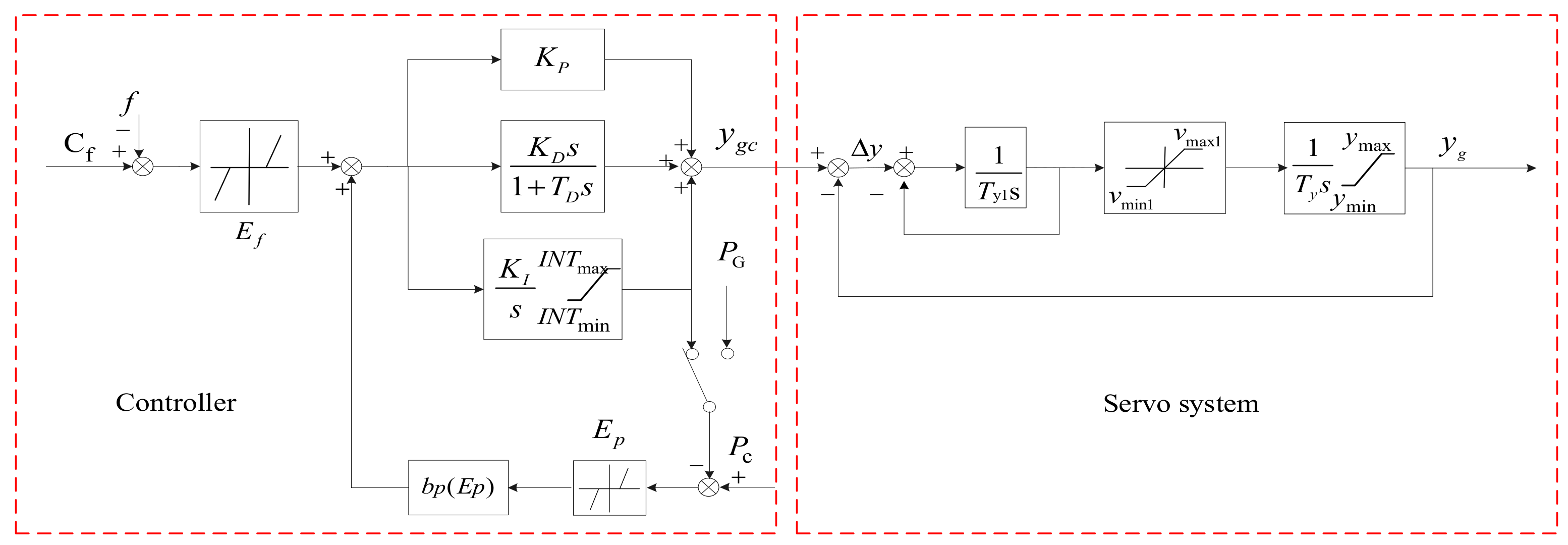



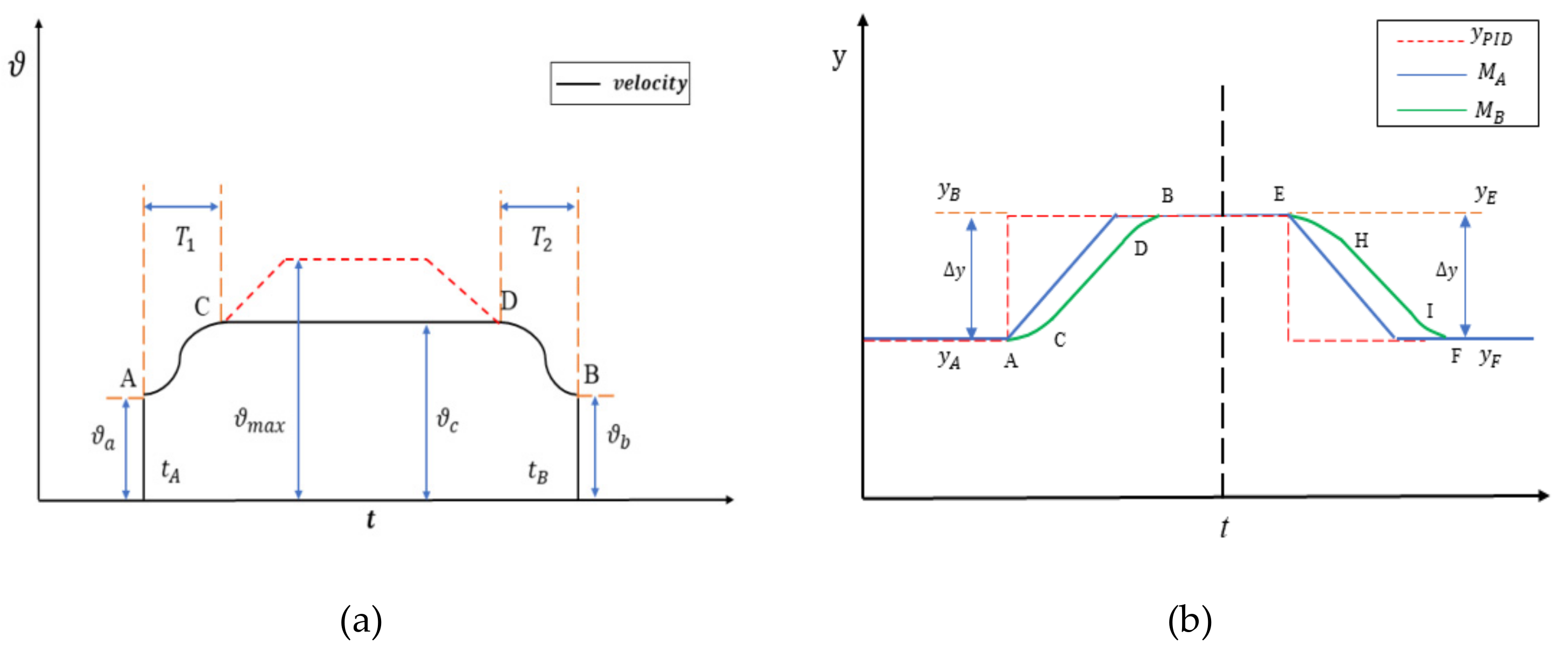
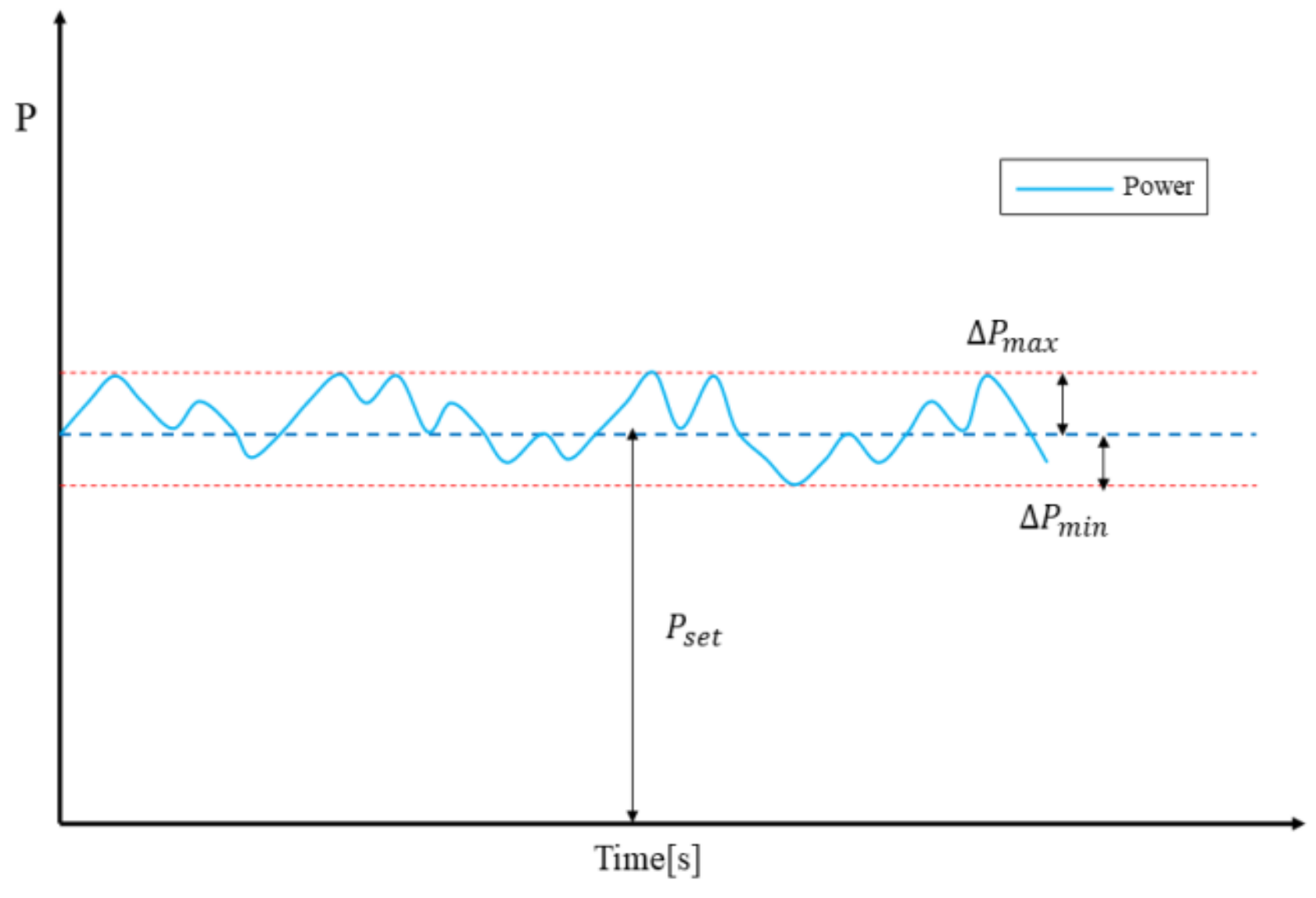
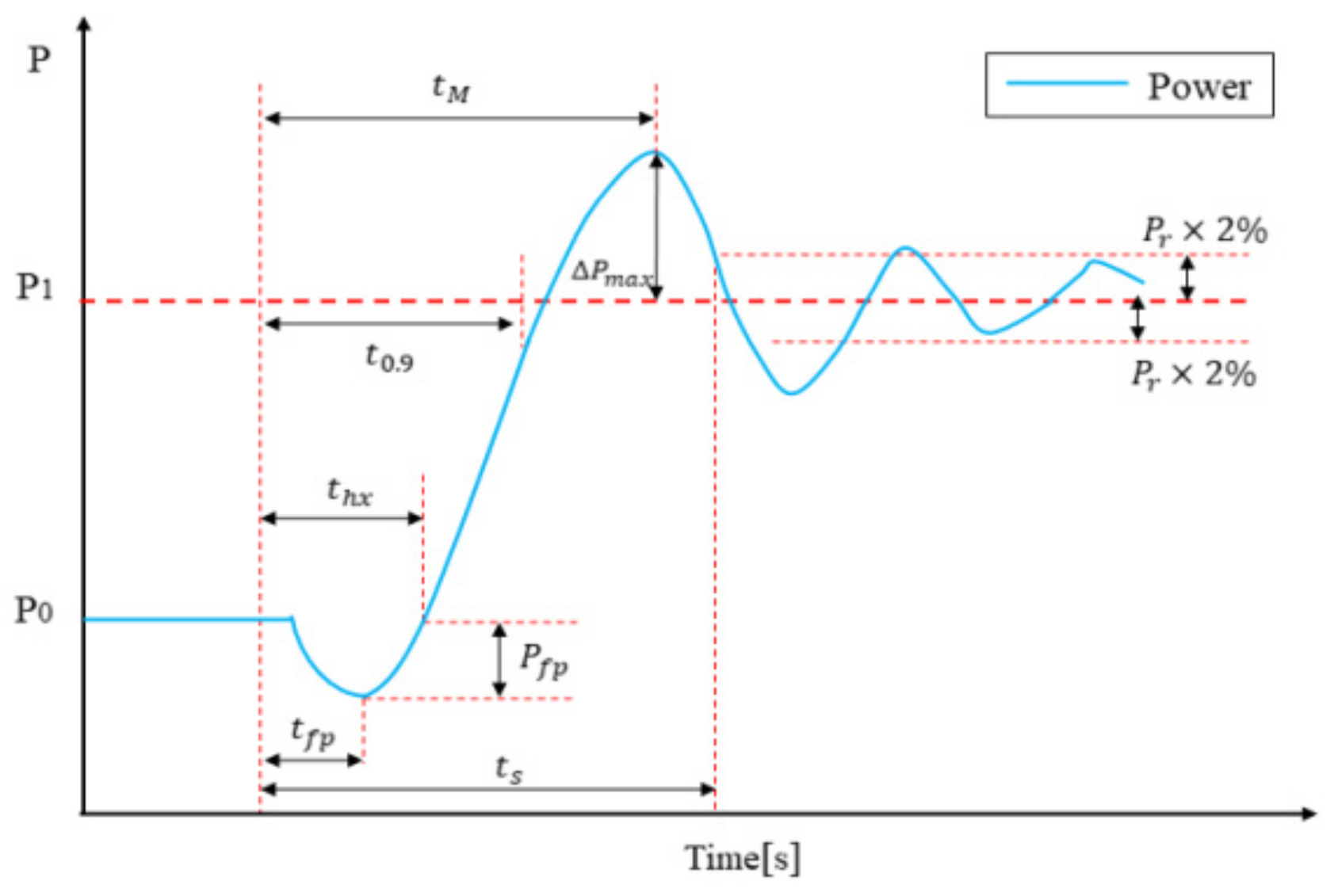
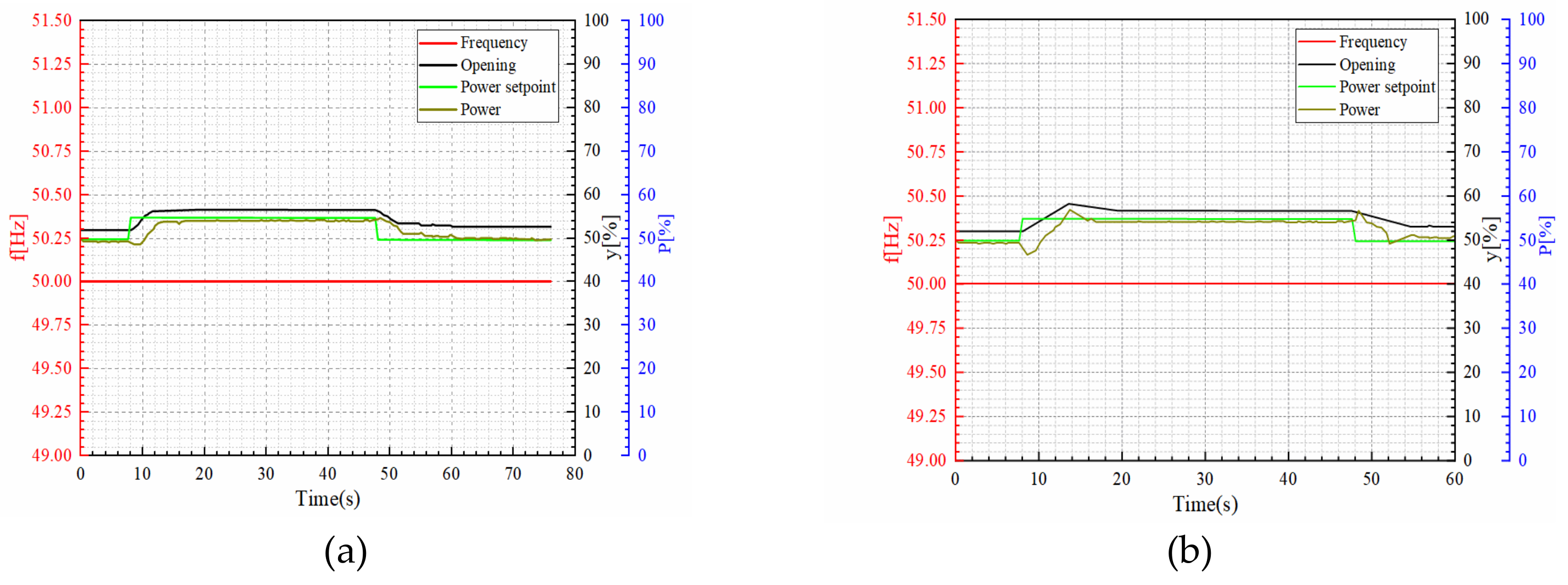
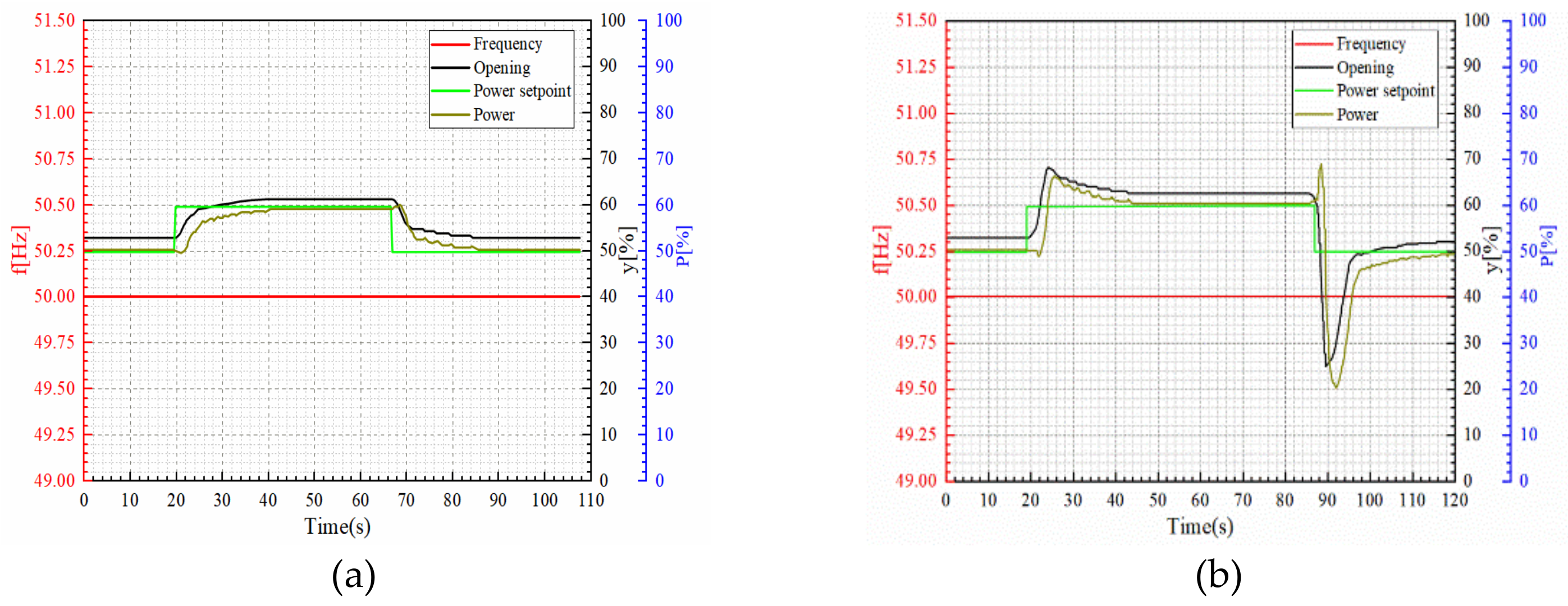
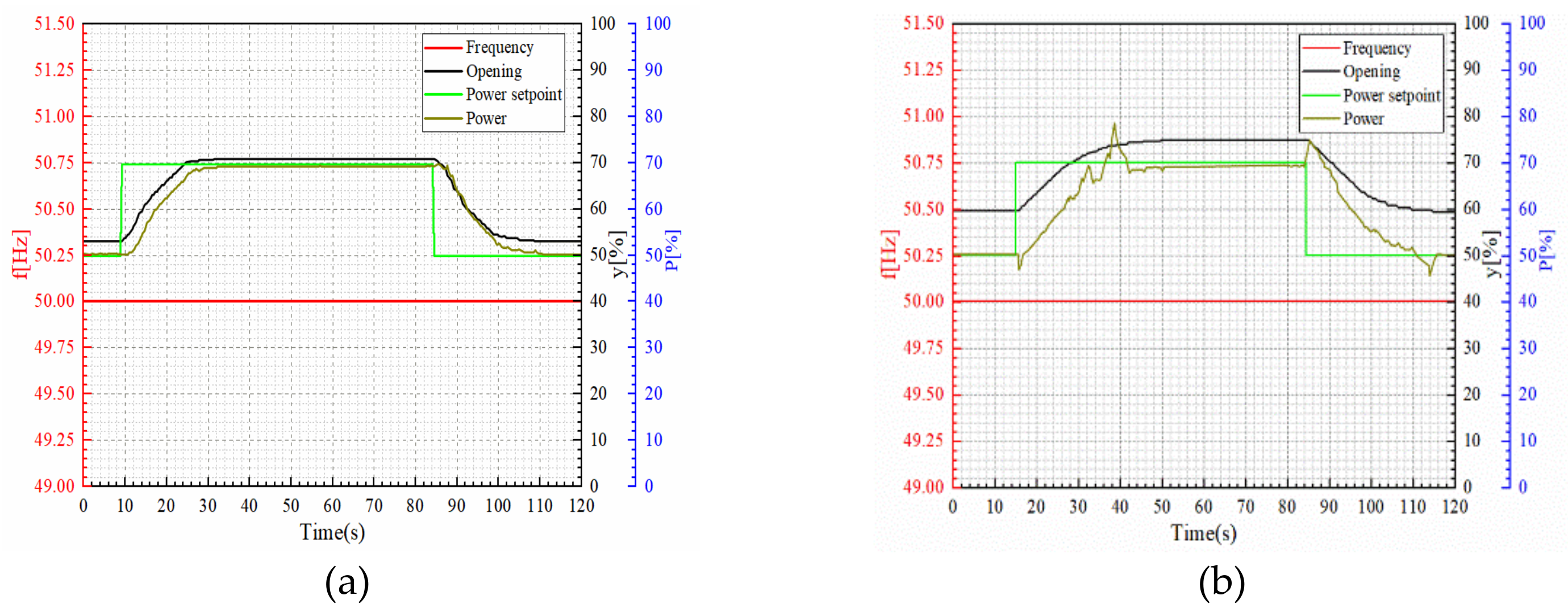
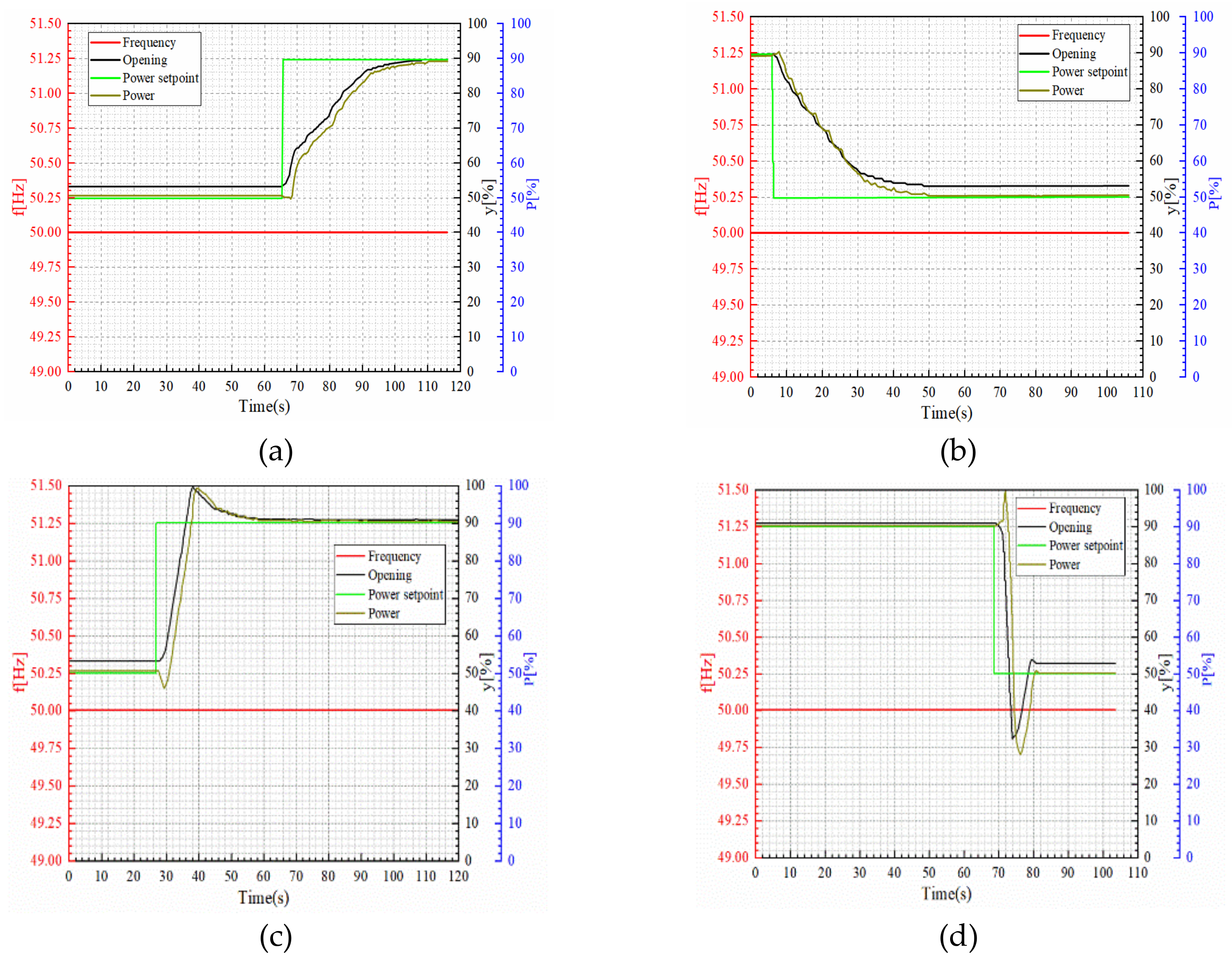
| Main Parameters | |||
|---|---|---|---|
| Turbine model | HL-LJ-630 | Generator model | SF140-64/13500 |
| Rated water head | 44 m | Rated capacity | 140 MVA |
| Rated speed | 93.75 r/min | Rated voltage | 10.5 kV |
| Rated output | 142.90 MW | Moment of inertia GD2 | 60,000 kN m2 |
| Rated flow rate | 352.57 m3/s | Rated power factor | 0.9 |
| Rate deficiency | 93.9% | Unit inertia time | 11.93 s |
| S | L | S | L | S | L | S | L | S | L | |
| Increase 5% | 0.5 | 0.8 | 0 | 2.5 | 0.7 | 3.1 | 1.8 | 2.6 | 6.8 | 9.6 |
| Decrease 5% | 0.3 | 0.9 | 0 | 0.8 | 0 | 0.6 | 0 | 1.2 | 8.02 | 9.9 |
| Increase 10% | 0.4 | 2 | 0 | 5.6 | 0.7 | 1.1 | 1.6 | 2.8 | 14.2 | 18.8 |
| Decrease 10% | 0.5 | 1.8 | 0 | 28 | 0.5 | 9.2 | 0.4 | 0.7 | 13.9 | 26 |
| S | L | S | L | S | L | S | L | S | L | |
| Increase 20% | 0.4 | 1.3 | 0 | 8.5 | 0 | 2.9 | 0 | 0.6 | 18.2 | 25.7 |
| Decrease 20% | 0.6 | 1.2 | 0 | 4.4 | 0 | 4.9 | 0 | 1.5 | 22.2 | 28.4 |
| Increase 40% | 0.5 | 1.5 | 0 | 9.3 | 0.2 | 4.6 | 0.6 | 1.7 | 34.7 | 23 |
| Decrease 40% | 0.4 | 1.1 | 0 | 21 | 0.4 | 9.7 | 0.5 | 1.8 | 33.4 | 24 |
Publisher’s Note: MDPI stays neutral with regard to jurisdictional claims in published maps and institutional affiliations. |
© 2021 by the authors. Licensee MDPI, Basel, Switzerland. This article is an open access article distributed under the terms and conditions of the Creative Commons Attribution (CC BY) license (http://creativecommons.org/licenses/by/4.0/).
Share and Cite
Wang, C.; Wang, D.-K.; Zhang, J.-M. Experimental Study on the Optimal Strategy for Power Regulation of Governing System of Hydropower Station. Water 2021, 13, 421. https://doi.org/10.3390/w13040421
Wang C, Wang D-K, Zhang J-M. Experimental Study on the Optimal Strategy for Power Regulation of Governing System of Hydropower Station. Water. 2021; 13(4):421. https://doi.org/10.3390/w13040421
Chicago/Turabian StyleWang, Cong, De-Kuan Wang, and Jian-Ming Zhang. 2021. "Experimental Study on the Optimal Strategy for Power Regulation of Governing System of Hydropower Station" Water 13, no. 4: 421. https://doi.org/10.3390/w13040421






